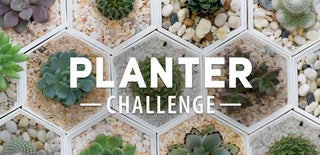Introduction: Book Terrarium Planter
Today I will show you how to make a small terrarium out of books!
Step 1: Find Your Books
Find a couple of old looking, hardback books from a used bookstore or thrift store. They shouldn't be too large, but the thicker the better. The more books you use the deeper your planter can be. The books also do not need to be the same size.
Try to find books with interesting names if possible. I found two called "Growth of the Soil" and "Bright Leaf", which I thought were appropriate.
Step 2: Gather Your Supplies
You will need:
- Books
- a glass dome (optional)
- an exacto blade
- a marker
- a ruler
- silicone sealant
- a brush
- spray on rubber coating and electrical tape (optional)
Step 3:
Step 4: Mark the Perimeter
Use the ruler to mark out a square that will be cut out of the book . Ignore the hole I already drilled into this book... it will be cut out anyway.
Keep in mind the diameter of the dome if you plan to make this into a terrarium like I did. If you are, the diagonal of the square must be equal to or less than the diameter of the dome.
Try to center the square as best you can on the book face.
Step 5: Start Cutting!
Now we are going to cut a hole in the smaller book, as this will go on top. Careful with the blade. Use a ruler to help guide the first few cuts.
Keep working your way through the book. Cut through several pages at a time, then pull them out. This will take awhile, and will be pretty messy, so be prepared.
Step 6: Prep the Second Book
Ta-da! Now its time for the next book.
Line up your first book on top of the second, and position them how you want the finished piece to look. You can have them lined up perfectly or slightly askew. I went with slightly askew.
Use the marker to trace the interior of the cutout onto the second book.
Step 7: Cutting, Round Two
Work your way through this book just like you did the first, except don't go all the way through! Leave a few pages left to give a nice thick bottom to your planter.
Tip: as you cut deeper, you can open the book to get better access. Don't worry about pages being slightly shifted or imperfect cuts. This will all be buried anyway.
Optional: While you are destroying these books, consider taking a moment to google the book title and to read a short summary of the plot. You should know what kind of literature your plants will be raised on, and it is a small gesture of respect to the author of your new planter.
Step 8: Make a Drainage Hole
Drill or poke a small hole at the bottom for drainage
Step 9: Seal the Inside
We will use the silicone to seal off the paper on the inside.
First, I used some sandpaper to try to smooth up the interior a bit. This might not be necessary, depending how good your cuts look.
Next, I glued the two books together by painting a thick layer of silicone on the bottom of the top book, then lined it up and stuck it to the top of the bottom book.
Finally, I generously coated the entire interior with the sealant using a paintbrush. I put some tape around the top perimeter so I would not accidentally get any silicone on a place that will be visible.
Tip: Make your silicone extra thick on the side away from the spine of the book. The silicone will hold the book closed,and putting extra here will give it a bit more strength to accomplish this.
Don't worry about how this looks. It will all be buried in the end anyway.
Step 10: Let It Dry Overnight While Compressed
The silicone needs to dry, and we want to keep the books firmly together while it does. I accomplished this by setting the books on the floor and stacking some heavy items on top.
Step 11: Add the Final Touches
I decided to spray a perimeter of black rubber coating to add a bit of an accent around the rim of the planter, and to protect the cover of the book from stray water/dirt. This is optional. I think it looks nice.
If you do this, be sure to protect the books well while spraying! Mask off everything to prevent accidental overspray.
Step 12: Add Your Plants!
I added a layer of pearlite at the bottom, then a layer of dirt, and finally some forest flora I collected. With the dome, this is a great habitat for these little scarlet cup mushrooms I found over the weekend!
Step 13: Enjoy!
Happy Making!

Participated in the
Planter Challenge













